
LiteRT
LiteRT continues the legacy of TensorFlow Lite as the trusted, high-performance runtime for on-device AI. Now with LiteRT Next, we're expanding our vision with a new generation of APIs designed for superior performance and simplified hardware acceleration. Discover what's next for on-device AI.
Stars: 815
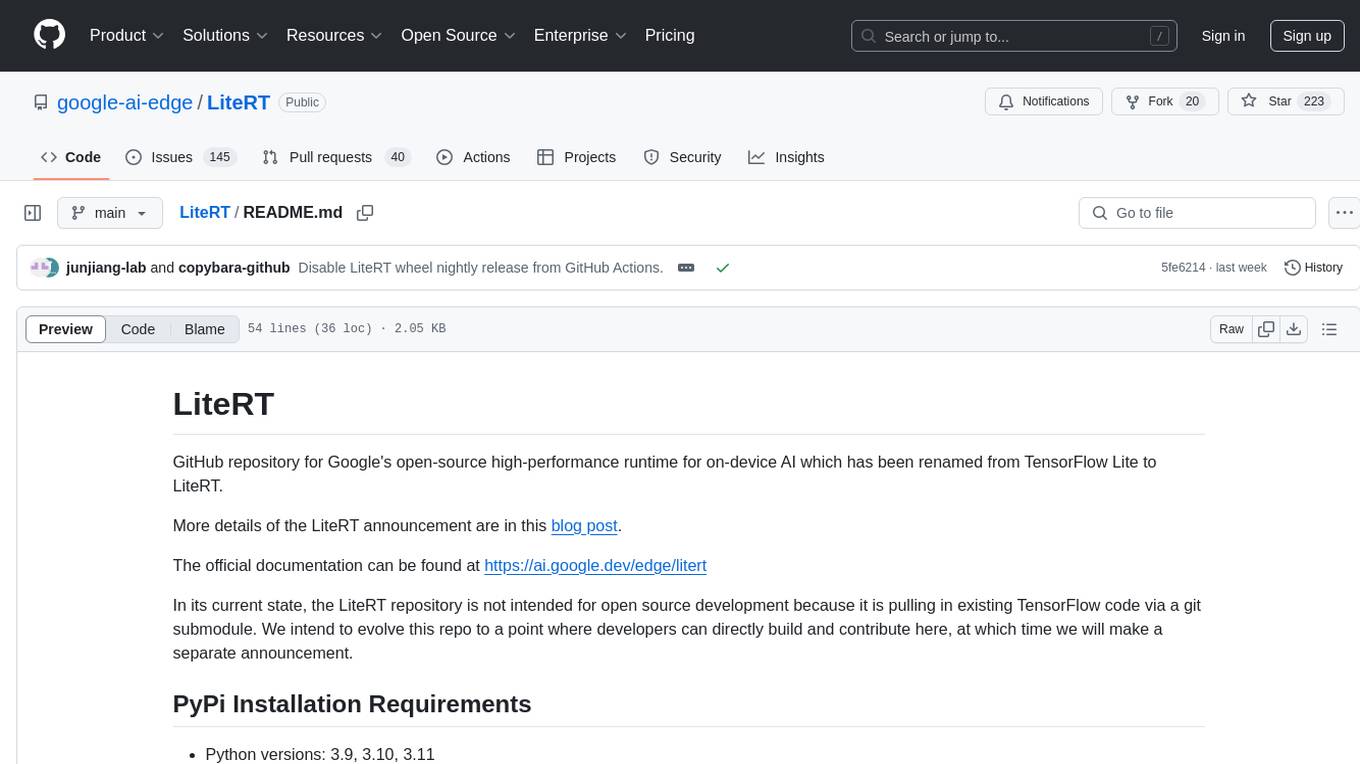
LiteRT is Google's open-source high-performance runtime for on-device AI, previously known as TensorFlow Lite. The repository is currently not intended for open-source development, but aims to evolve to allow direct building and contributions. LiteRT supports Python versions 3.9, 3.10, 3.11 on Linux and MacOS. It ensures compatibility with existing .tflite file extension and format, offering conversion tools and continued active development under the name LiteRT.
README:
Google's On-device framework for high-performance ML & GenAI deployment on edge platforms, via efficient conversion, runtime, and optimization
📖 Get Started | 🤝 Contributing | 📜 License | 🛡 Security Policy | 📄 Documentation
LiteRT continues the legacy of TensorFlow Lite as the trusted, high-performance runtime for on-device AI.
LiteRT V2 (aka Next as announced at Google IO '25), introduced a new set of APIs, featuring advanced GPU/NPU acceleration, delivering superior performance, and making on-device ML inference easier than ever.
- LiteRT V2 is an alpha release and under active development.
- Join LiteRT NPU Early access program: g.co/ai/LiteRT-NPU-EAP
-
🆕 New LiteRT v2 API: Streamline development with automated accelerator selection, true async execution, and efficient I/O buffer handling.
- Automated accelerator selection vs explicit delegate creation
- Async execution for faster overall execution time
- Easy NPU runtime and model distribution
- Efficient I/O buffer handling
-
🤖 Unified NPU Acceleration: Offer seamless access to NPUs from major chipset providers with a consistent developer experience. LiteRT NPU acceleration is available through an Early Access Program.
-
⚡ Best-in-class GPU Performance: Use state-of-the-art GPU acceleration for on-device ML. The new buffer interoperability enables zero-copy and minimizes latency across various GPU buffer types.
-
🧠 Superior Generative AI inference: Enable the simplest integration with the best performance for GenAI models.
LiteRT is designed for cross-platform deployment on a wide range of hardware.
| Platform | CPU Support | GPU Support | NPU Support |
|---|---|---|---|
| 🤖 Android | ✅ | ✅ OpenCL WebGPU* |
Google Tensor* ✅ Qualcomm ✅ MediaTek S.SLI* |
| 🍎 iOS | ✅ | Metal* | ANE* |
| 🐧 Linux | ✅ | WebGPU* | N/A |
| 🍎 macOS | ✅ | Metal* | ANE* |
| 💻 Windows | ✅ | WebGPU* | Intel* |
| 🌐 Web | Coming soon | Coming soon | Coming soon |
| 🧩 Embedded | Broadcom* Raspberry Pi* |
*Coming soon
Coming soon...
For a comprehensive guide to setting up your application with LiteRT Next, see the Get Started guide.
You can build LiteRT from source:
- Start a docker daemon.
- Run
build_with_docker.shunderdocker_build/
The script automatically creates a Linux Docker image, which allows you to build artifacts for Linux and Android (through cross compilation). See build instructions in BUILD_INSTRUCTIONS.md for more information on how to build runtime libraries with the docker container.
For more information about using docker interactive shell or building different
targets, please refer to docker_build/README.md.
Every developer's path is different. Here are a few common journeys to help you get started based on your goals:
- Goal: Convert a model from PyTorch to run on LiteRT.
-
Path1 (classic models): Use the
AI Edge Torch Converter to
transform your PyTorch model into the
.tfliteformat, and use AI Edge Quantizer to optimize the model for optimal performance under resource constraints. From there, you can deploy it using the standard LiteRT runtime. - Path2 (LLMs): Use Torch Generative API to reauthor and convert your PyTorch LLMs into Apache format, and deploy it using LiteRT LM.
- Goal: Run a pre-trained model (like image segmentation) in a mobile app for the first time.
- Path1 (Beginner dev): Follow step-by-step instructions via Android Studio to create a Real-time segmentation App for CPU/GPU/NPU inference. Source code link.
- Path2 (Experienced dev): Start with the Get Started guide, find a pre-trained .tflite model on Kaggle Models, and use the standard LiteRT runtime to integrate it into your Android or iOS app.
- Goal: Accelerate an existing model to run faster and more efficiently on-device.
-
Path:
- Explore the LiteRT API to easily leverage hardware acceleration. Learn how to enable the GPU acceleration or the NPU acceleration (NPU EAP: g.co/ai/LiteRT-NPU-EAP).
- For working with Generative AI: Dive into LiteRT LM, our specialized solution for running GenAI models.
- Goal: Deploy a large language model (LLM) or diffusion model on a mobile device.
- Path: Dive into LiteRT LM, our specialized solution for running GenAI models. You'll focus on model quantization and optimizations specific to large model architectures.
Where Next:
Beta by Dec 2025:
- Achieve feature parity with TensorFlow Lite
- Upgrade GPU Acceleration to ML SDK, Metal and more advanced version
- Simplify Android development with Maven, Android Studio, and Google Tensor
- Proactively increase ML and GenAI model coverage
- Enable Certain support
- Broader LiteRT Runtime/Converter upgrades from TensorFlow Lite
General Availability by Google IO, May 2026
Our commitment is to make LiteRT the best runtime for any on-device ML deployment. The above roadmap is defined based on the following product strategy:
- Expanding Hardware Acceleration: Broadening our support for NPUs and improving performance across all major hardware accelerators.
- Generative AI Optimizations: Introducing new optimizations and features specifically for the next wave of on-device generative AI models.
- Improving Developer Tools: Building better tools for debugging, profiling, and optimizing models.
- Platform Support: Enhancing support for core platforms and exploring new ones.
Going forward, LiteRT will establish a release cadence for minor release every 4-6 weeks.
This roadmap is subject to change. We encourage community feedback—please open an issue to discuss proposals or ideas!
We welcome contributions to LiteRT. Please see the CONTRIBUTING.md file for more information on how to contribute.
We encourage you to reach out if you need help.
- GitHub Issues: For bug reports and feature requests, please file a new issue on our GitHub Issues page.
- GitHub Discussions: For questions, general discussions, and community support, please visit our GitHub Discussions.
LiteRT is part of a larger ecosystem of tools for on-device machine learning. Check out these other projects from Google:
- LiteRT Samples: A collection of LiteRT sample apps.
- AI Edge Torch Converter: A tool in LiteRT to convert PyTorch models into the LiteRT(.tflite) format for on-device deployment.
- Torch Generative API: A library in LiteRT to reauthor LLMs for efficient conversion and on-device inference.
- LiteRT-LM: A library to efficiently run Large Language Models (LLMs) across edge platforms, built on top of LiteRT.
- XNNPACK: A highly optimized library of neural network inference operators for ARM, x86, and WebAssembly architectures that provides high-performance CPU acceleration for LiteRT.
- V2 GPU Delegate - Coming soon
- MediaPipe: A framework for building cross-platform, customizable ML solutions for live and streaming media.
This project is dedicated to fostering an open and welcoming environment. Please read our Code of Conduct to understand the standards of behavior we expect from all participants in our community.
LiteRT is licensed under the Apache-2.0 License.
For Tasks:
Click tags to check more tools for each tasksFor Jobs:
Alternative AI tools for LiteRT
Similar Open Source Tools

LiteRT
LiteRT is Google's open-source high-performance runtime for on-device AI, previously known as TensorFlow Lite. The repository is currently not intended for open-source development, but aims to evolve to allow direct building and contributions. LiteRT supports Python versions 3.9, 3.10, 3.11 on Linux and MacOS. It ensures compatibility with existing .tflite file extension and format, offering conversion tools and continued active development under the name LiteRT.
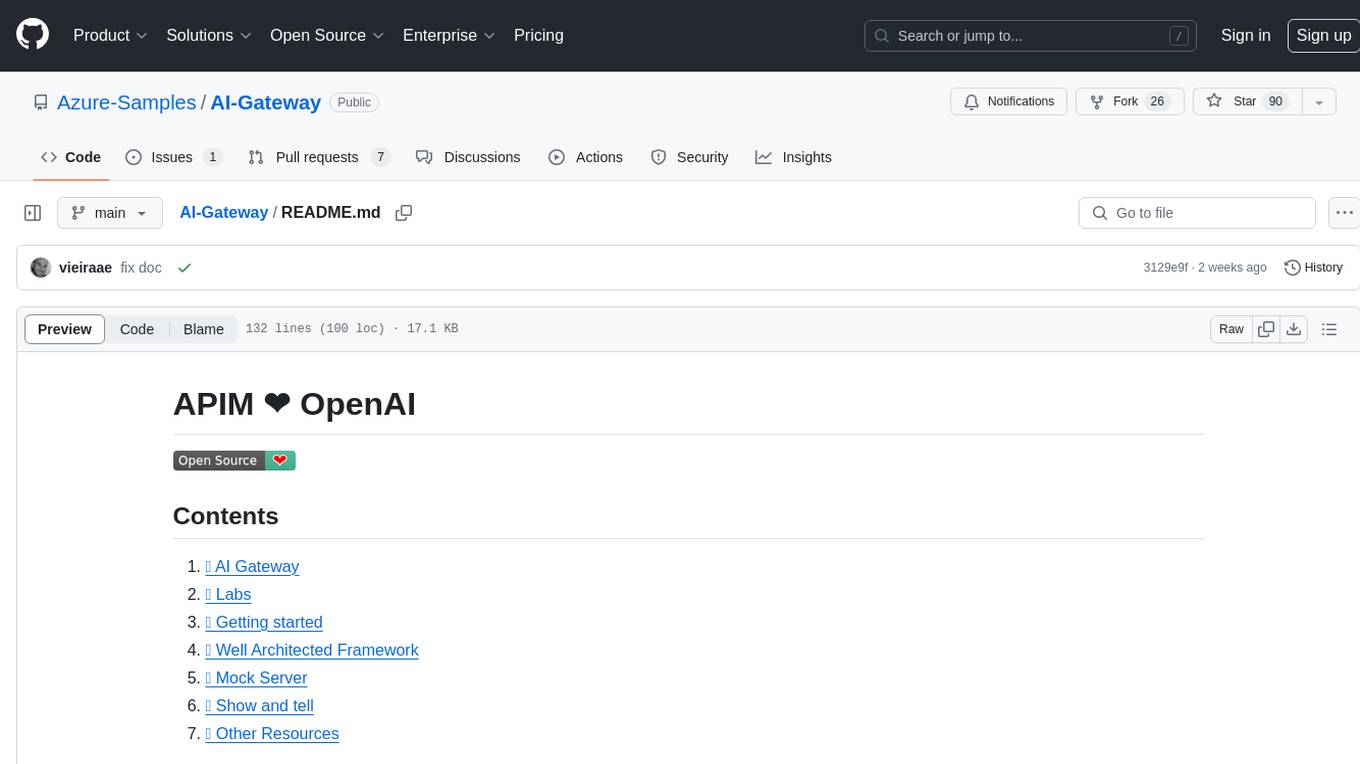
AI-Gateway
The AI-Gateway repository explores the AI Gateway pattern through a series of experimental labs, focusing on Azure API Management for handling AI services APIs. The labs provide step-by-step instructions using Jupyter notebooks with Python scripts, Bicep files, and APIM policies. The goal is to accelerate experimentation of advanced use cases and pave the way for further innovation in the rapidly evolving field of AI. The repository also includes a Mock Server to mimic the behavior of the OpenAI API for testing and development purposes.
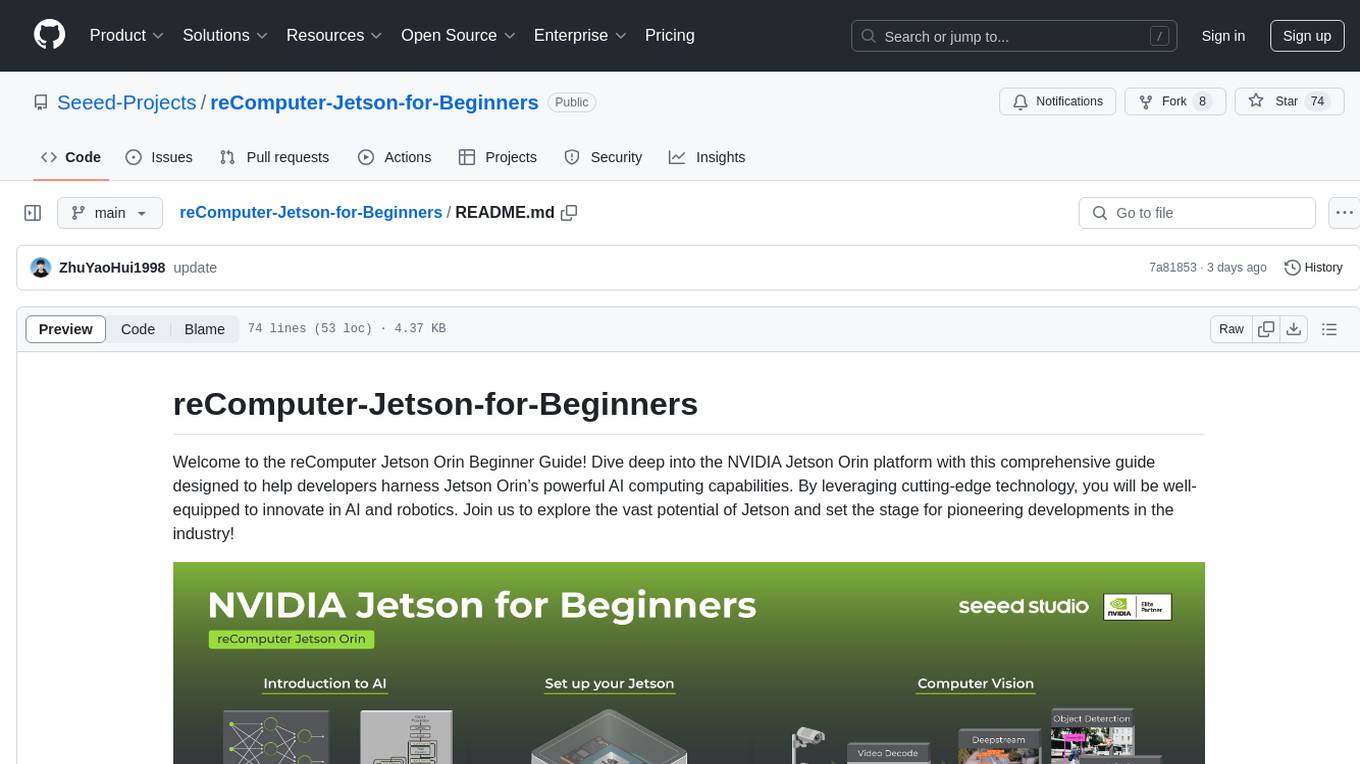
reComputer-Jetson-for-Beginners
The reComputer Jetson Orin Beginner Guide is a comprehensive resource designed to help developers explore and harness the powerful AI computing capabilities of the NVIDIA Jetson Orin platform. The guide covers a wide range of topics, from basic tools and getting started to advanced applications in computer vision, generative AI, robotics, and more. With step-by-step tutorials and hands-on projects, users can learn to master NVIDIA's core technologies and popular AI frameworks, enabling them to innovate in AI and robotics. The guide is suitable for beginners looking to dive into AI development and build cutting-edge projects with Jetson Orin.
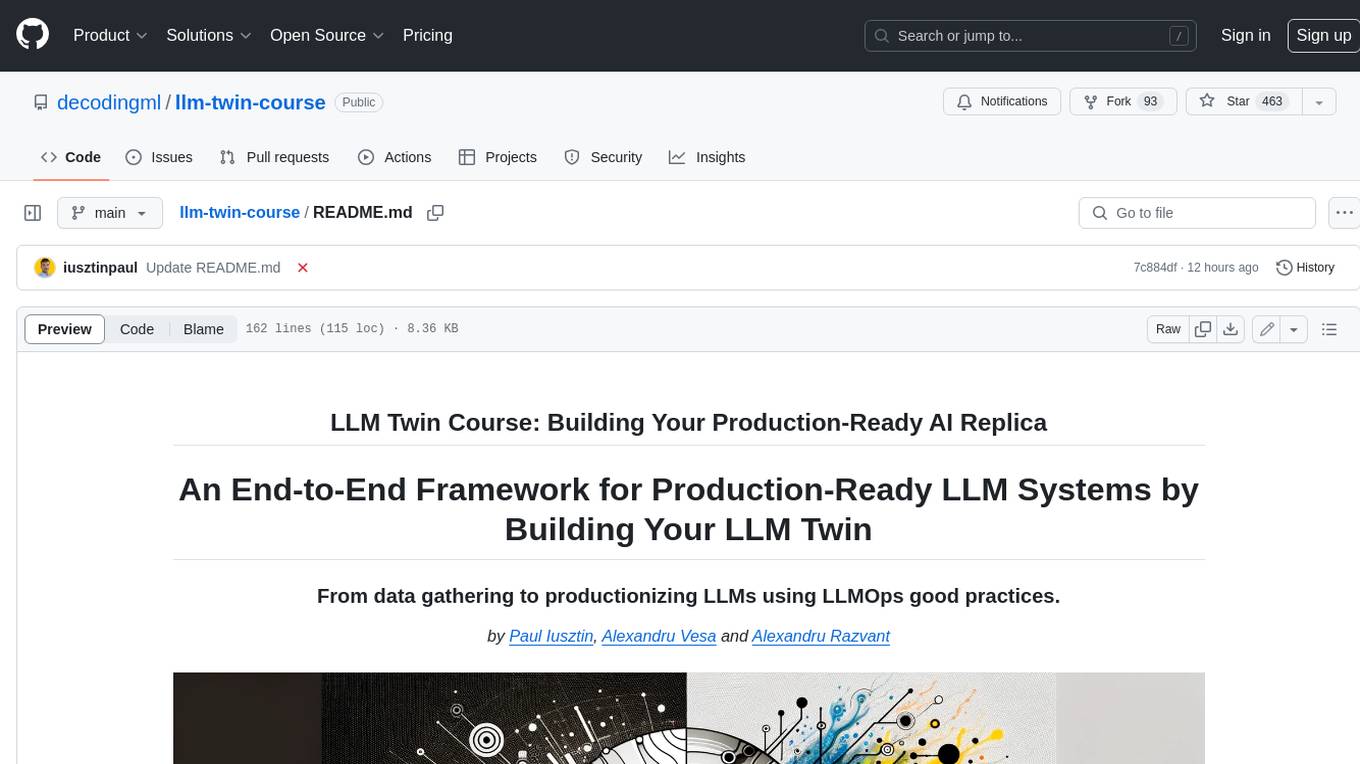
llm-twin-course
The LLM Twin Course is a free, end-to-end framework for building production-ready LLM systems. It teaches you how to design, train, and deploy a production-ready LLM twin of yourself powered by LLMs, vector DBs, and LLMOps good practices. The course is split into 11 hands-on written lessons and the open-source code you can access on GitHub. You can read everything and try out the code at your own pace.
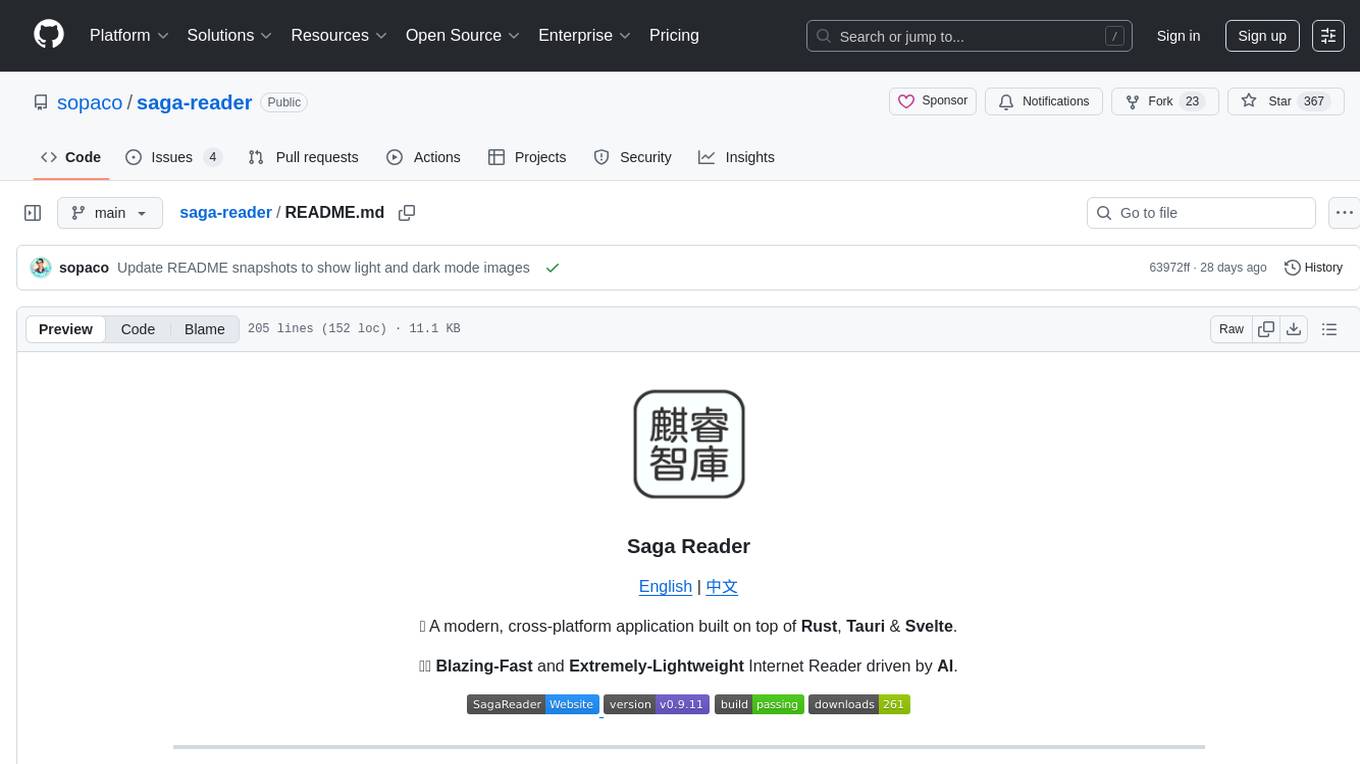
saga-reader
Saga Reader is an AI-driven think tank-style reader that automatically retrieves information from the internet based on user-specified topics and preferences. It uses cloud or local large models to summarize and provide guidance, and it includes an AI-driven interactive companion reading function, allowing you to discuss and exchange ideas with AI about the content you've read. Saga Reader is completely free and open-source, meaning all data is securely stored on your own computer and is not controlled by third-party service providers. Additionally, you can manage your subscription keywords based on your interests and preferences without being disturbed by advertisements and commercialized content.
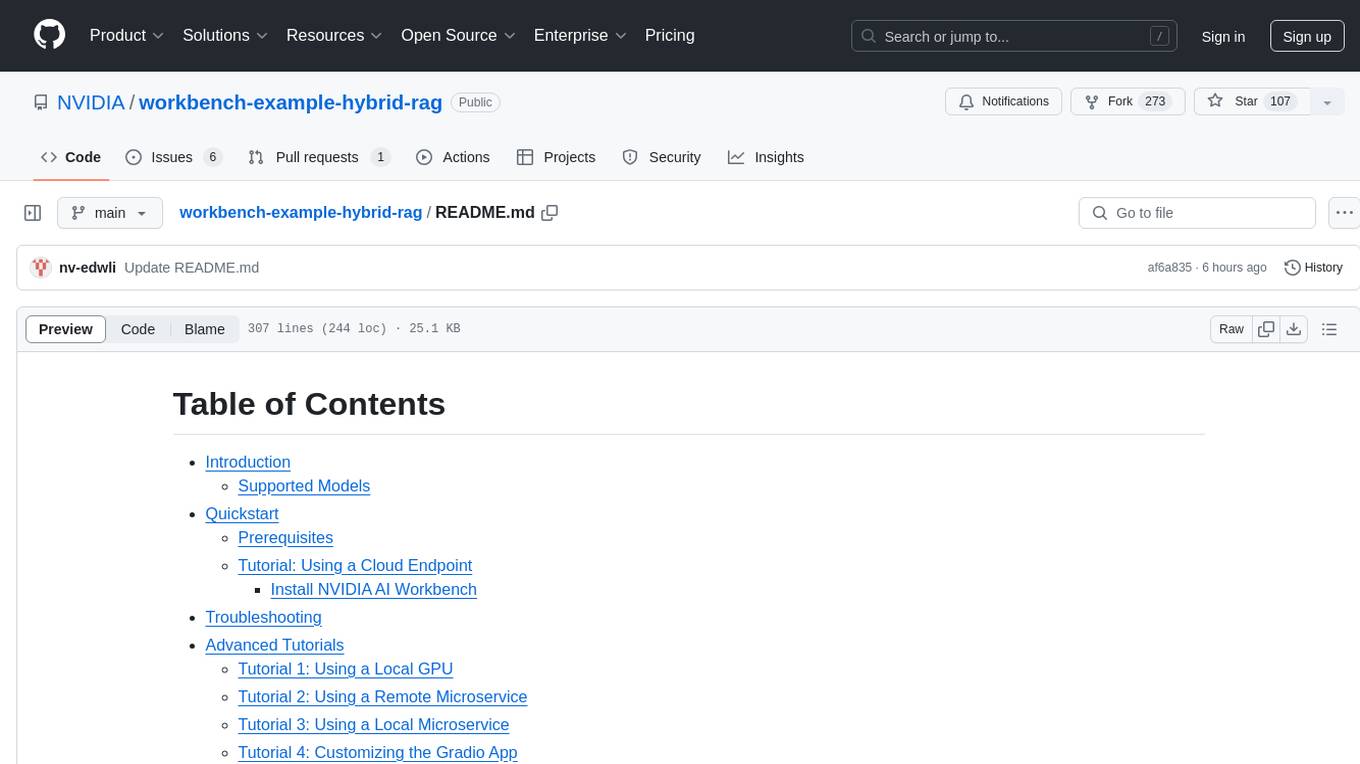
workbench-example-hybrid-rag
This NVIDIA AI Workbench project is designed for developing a Retrieval Augmented Generation application with a customizable Gradio Chat app. It allows users to embed documents into a locally running vector database and run inference locally on a Hugging Face TGI server, in the cloud using NVIDIA inference endpoints, or using microservices via NVIDIA Inference Microservices (NIMs). The project supports various models with different quantization options and provides tutorials for using different inference modes. Users can troubleshoot issues, customize the Gradio app, and access advanced tutorials for specific tasks.
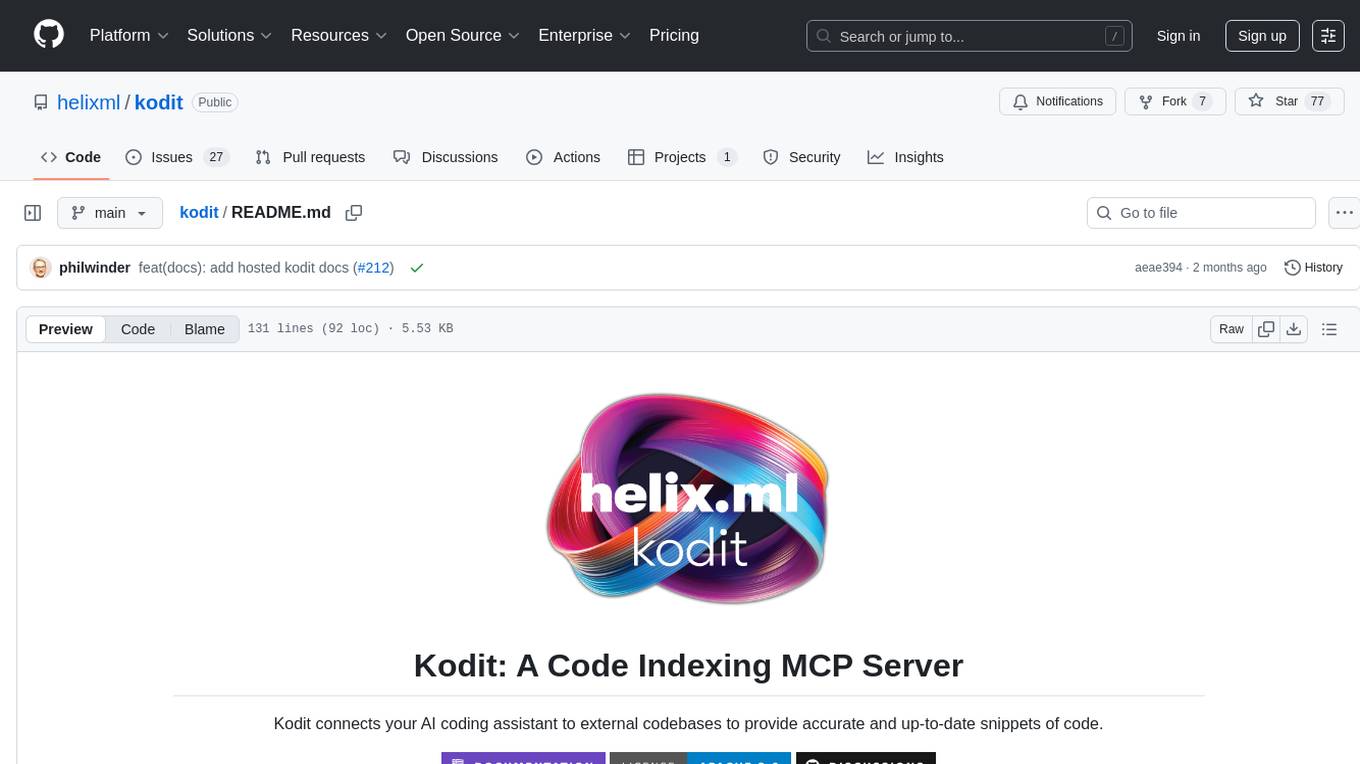
kodit
Kodit is a Code Indexing MCP Server that connects AI coding assistants to external codebases, providing accurate and up-to-date code snippets. It improves AI-assisted coding by offering canonical examples, indexing local and public codebases, integrating with AI coding assistants, enabling keyword and semantic search, and supporting OpenAI-compatible or custom APIs/models. Kodit helps engineers working with AI-powered coding assistants by providing relevant examples to reduce errors and hallucinations.
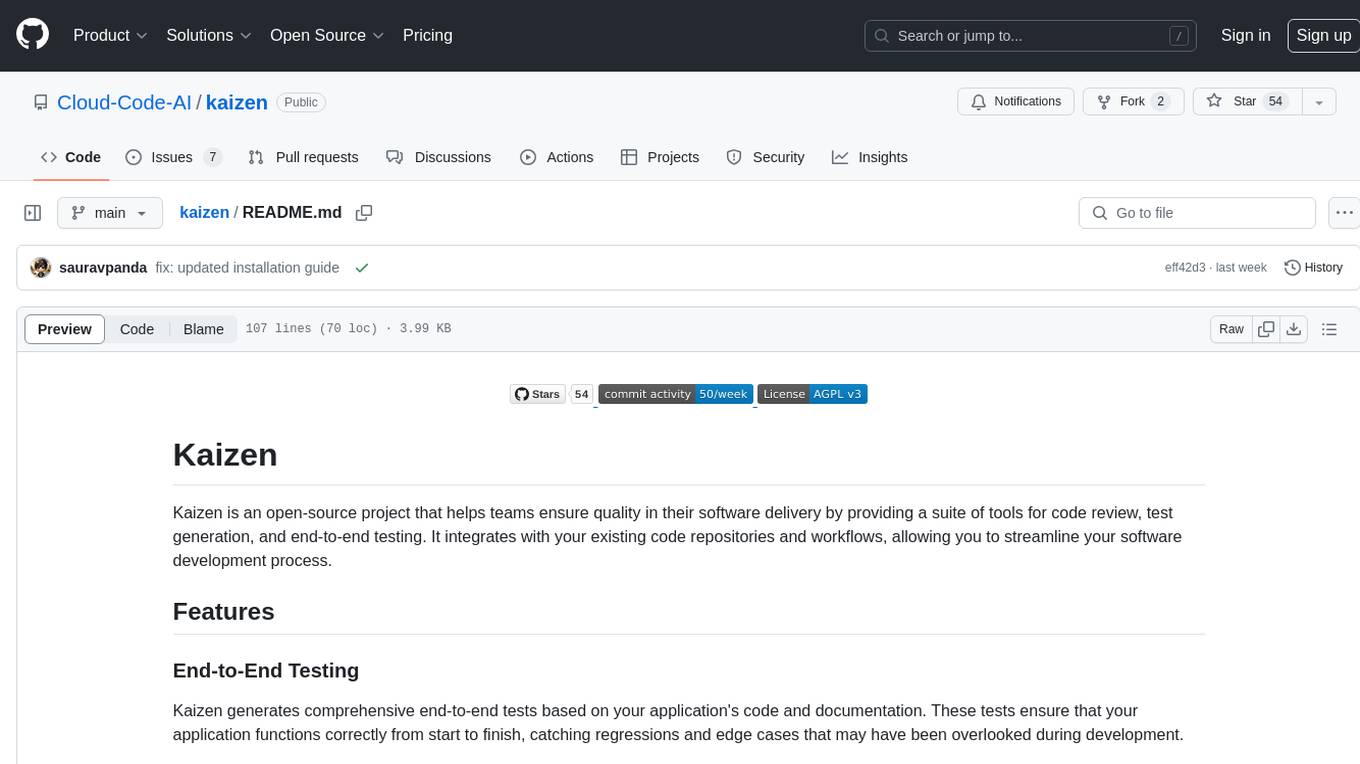
kaizen
Kaizen is an open-source project that helps teams ensure quality in their software delivery by providing a suite of tools for code review, test generation, and end-to-end testing. It integrates with your existing code repositories and workflows, allowing you to streamline your software development process. Kaizen generates comprehensive end-to-end tests, provides UI testing and review, and automates code review with insightful feedback. The file structure includes components for API server, logic, actors, generators, LLM integrations, documentation, and sample code. Getting started involves installing the Kaizen package, generating tests for websites, and executing tests. The tool also runs an API server for GitHub App actions. Contributions are welcome under the AGPL License.
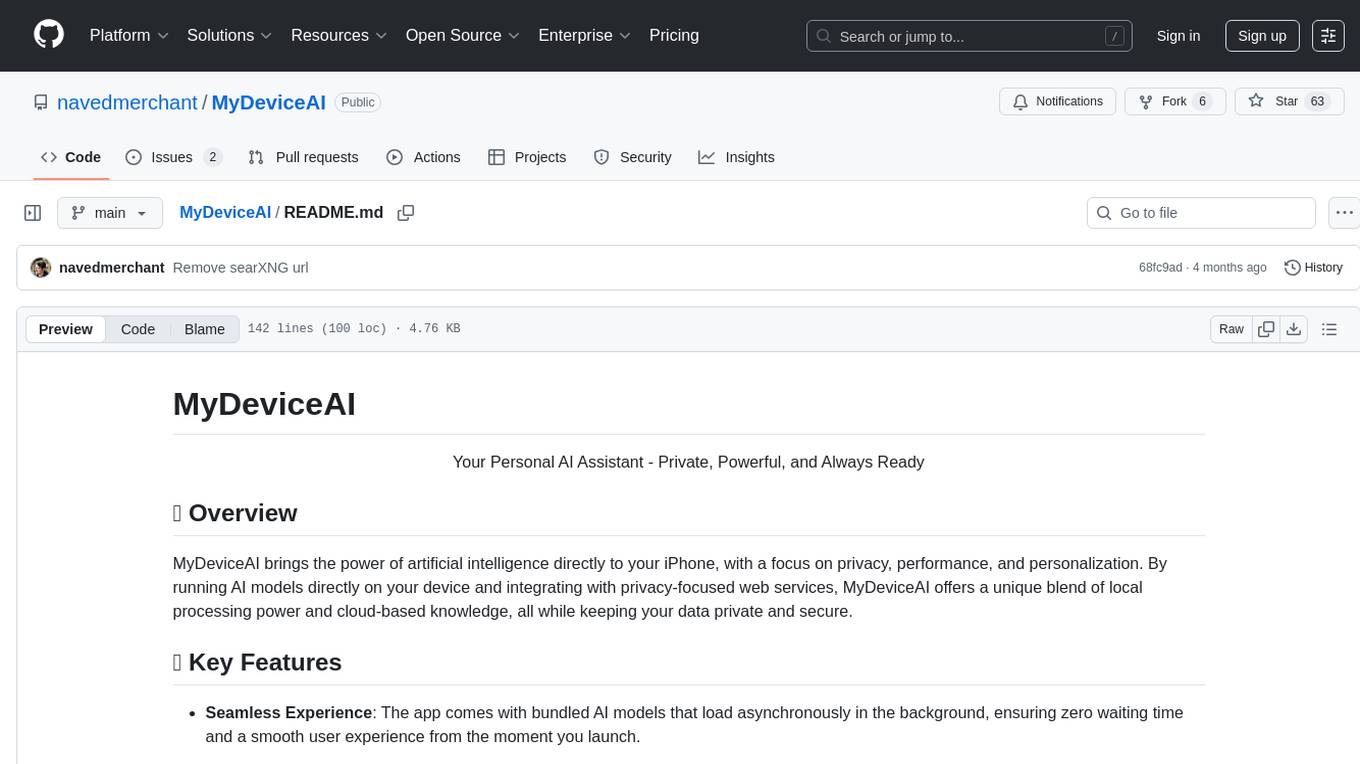
MyDeviceAI
MyDeviceAI is a personal AI assistant app for iPhone that brings the power of artificial intelligence directly to the device. It focuses on privacy, performance, and personalization by running AI models locally and integrating with privacy-focused web services. The app offers seamless user experience, web search integration, advanced reasoning capabilities, personalization features, chat history access, and broad device support. It requires macOS, Xcode, CocoaPods, Node.js, and a React Native development environment for installation. The technical stack includes React Native framework, AI models like Qwen 3 and BGE Small, SearXNG integration, Redux for state management, AsyncStorage for storage, Lucide for UI components, and tools like ESLint and Prettier for code quality.
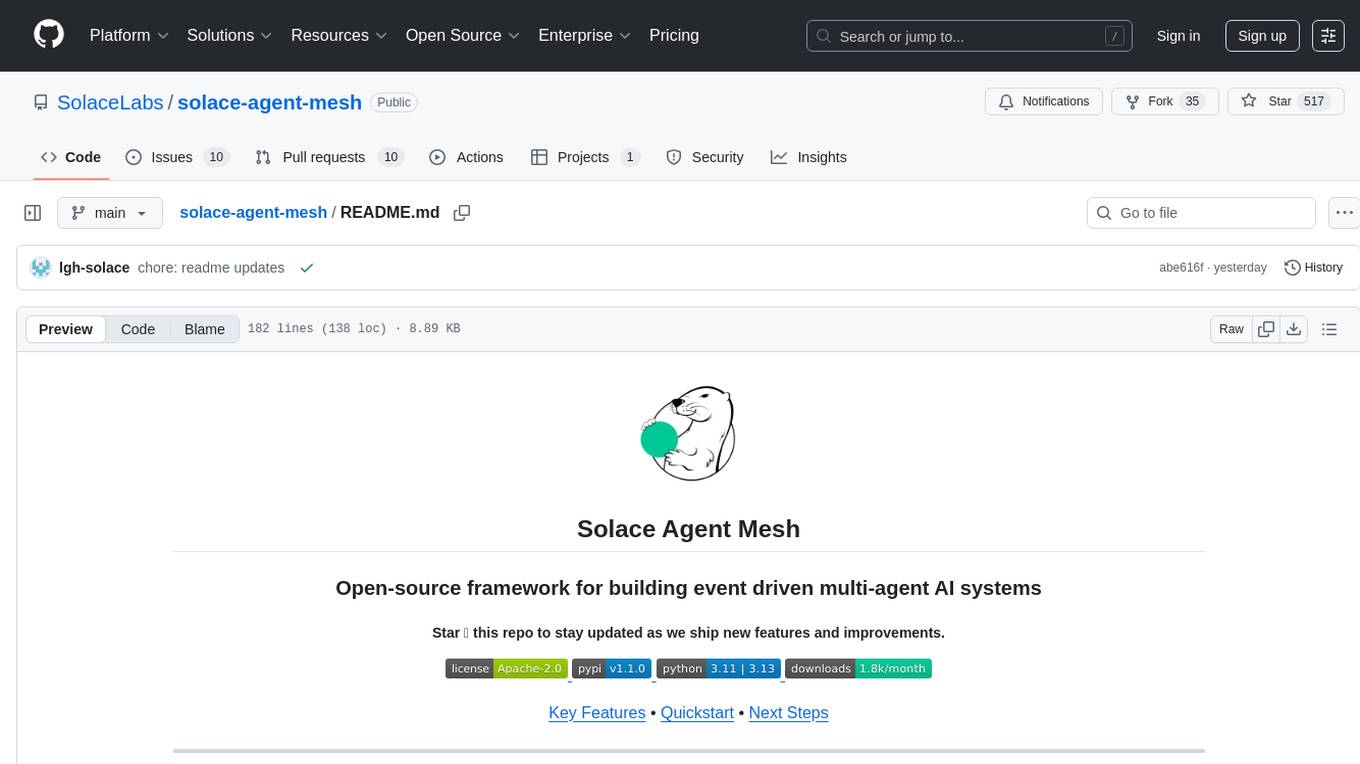
solace-agent-mesh
Solace Agent Mesh is an open-source framework designed for building event-driven multi-agent AI systems. It enables the creation of teams of AI agents with distinct skills and tools, facilitating communication and task delegation among agents. The framework is built on top of Solace AI Connector and Google's Agent Development Kit, providing a standardized communication layer for asynchronous, event-driven AI agent architecture. Solace Agent Mesh supports agent orchestration, flexible interfaces, extensibility, agent-to-agent communication, and dynamic embeds, making it suitable for developing complex AI applications with scalability and reliability.
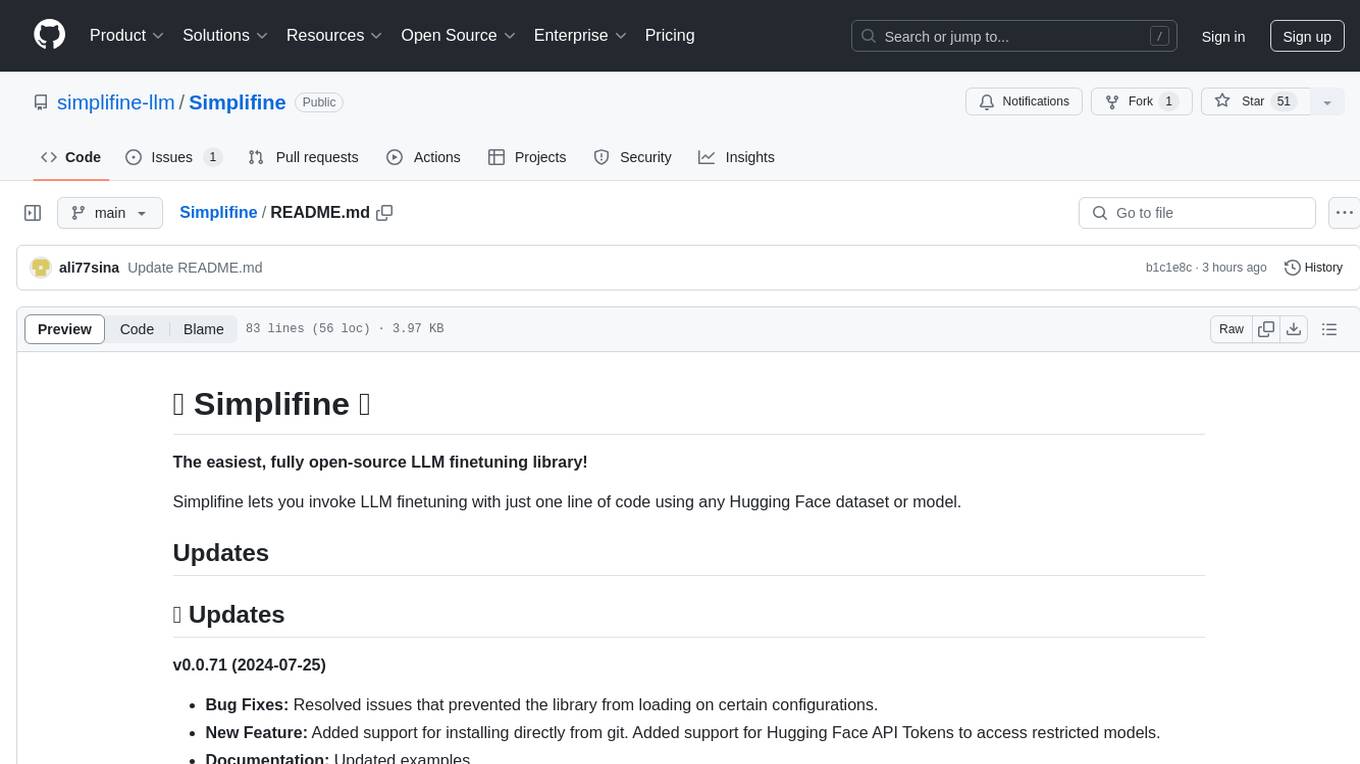
Simplifine
Simplifine is an open-source library designed for easy LLM finetuning, enabling users to perform tasks such as supervised fine tuning, question-answer finetuning, contrastive loss for embedding tasks, multi-label classification finetuning, and more. It provides features like WandB logging, in-built evaluation tools, automated finetuning parameters, and state-of-the-art optimization techniques. The library offers bug fixes, new features, and documentation updates in its latest version. Users can install Simplifine via pip or directly from GitHub. The project welcomes contributors and provides comprehensive documentation and support for users.
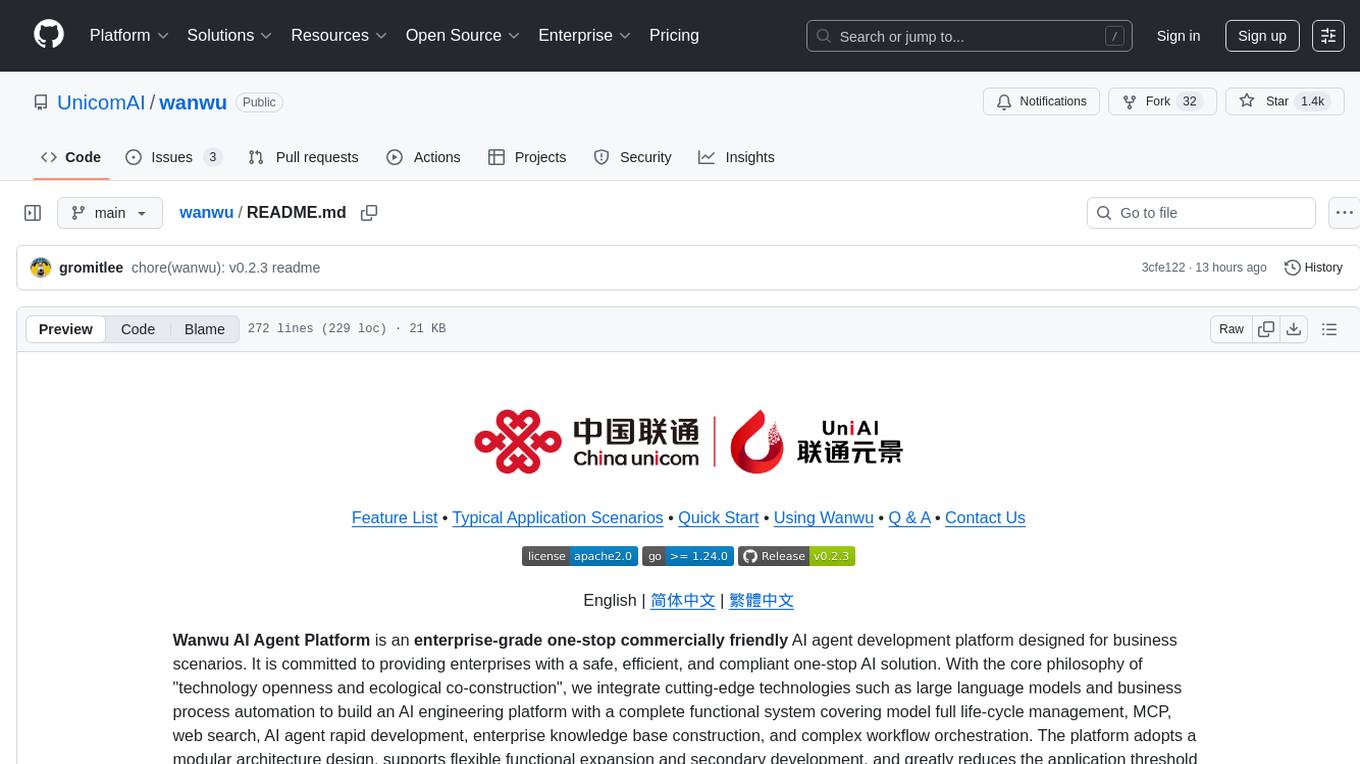
wanwu
Wanwu AI Agent Platform is an enterprise-grade one-stop commercially friendly AI agent development platform designed for business scenarios. It provides enterprises with a safe, efficient, and compliant one-stop AI solution. The platform integrates cutting-edge technologies such as large language models and business process automation to build an AI engineering platform covering model full life-cycle management, MCP, web search, AI agent rapid development, enterprise knowledge base construction, and complex workflow orchestration. It supports modular architecture design, flexible functional expansion, and secondary development, reducing the application threshold of AI technology while ensuring security and privacy protection of enterprise data. It accelerates digital transformation, cost reduction, efficiency improvement, and business innovation for enterprises of all sizes.
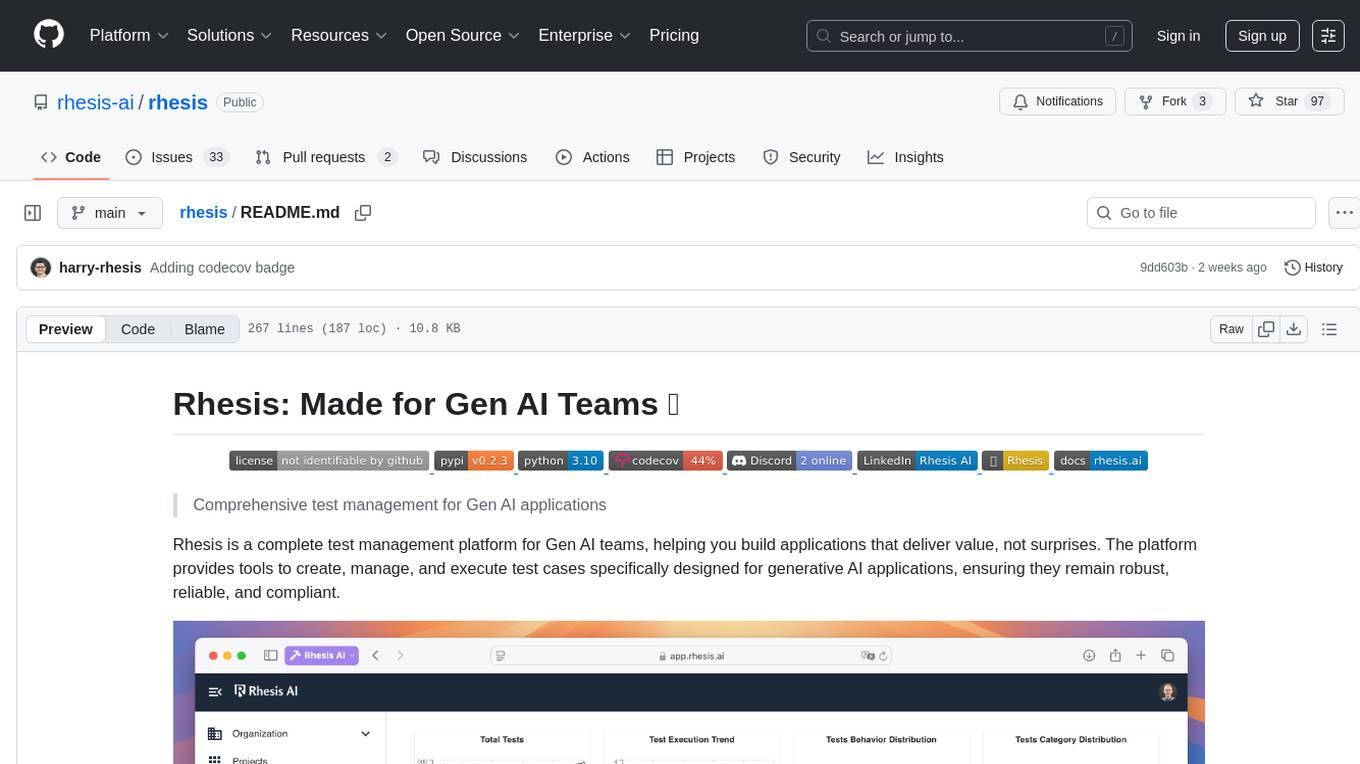
rhesis
Rhesis is a comprehensive test management platform designed for Gen AI teams, offering tools to create, manage, and execute test cases for generative AI applications. It ensures the robustness, reliability, and compliance of AI systems through features like test set management, automated test generation, edge case discovery, compliance validation, integration capabilities, and performance tracking. The platform is open source, emphasizing community-driven development, transparency, extensible architecture, and democratizing AI safety. It includes components such as backend services, frontend applications, SDK for developers, worker services, chatbot applications, and Polyphemus for uncensored LLM service. Rhesis enables users to address challenges unique to testing generative AI applications, such as non-deterministic outputs, hallucinations, edge cases, ethical concerns, and compliance requirements.
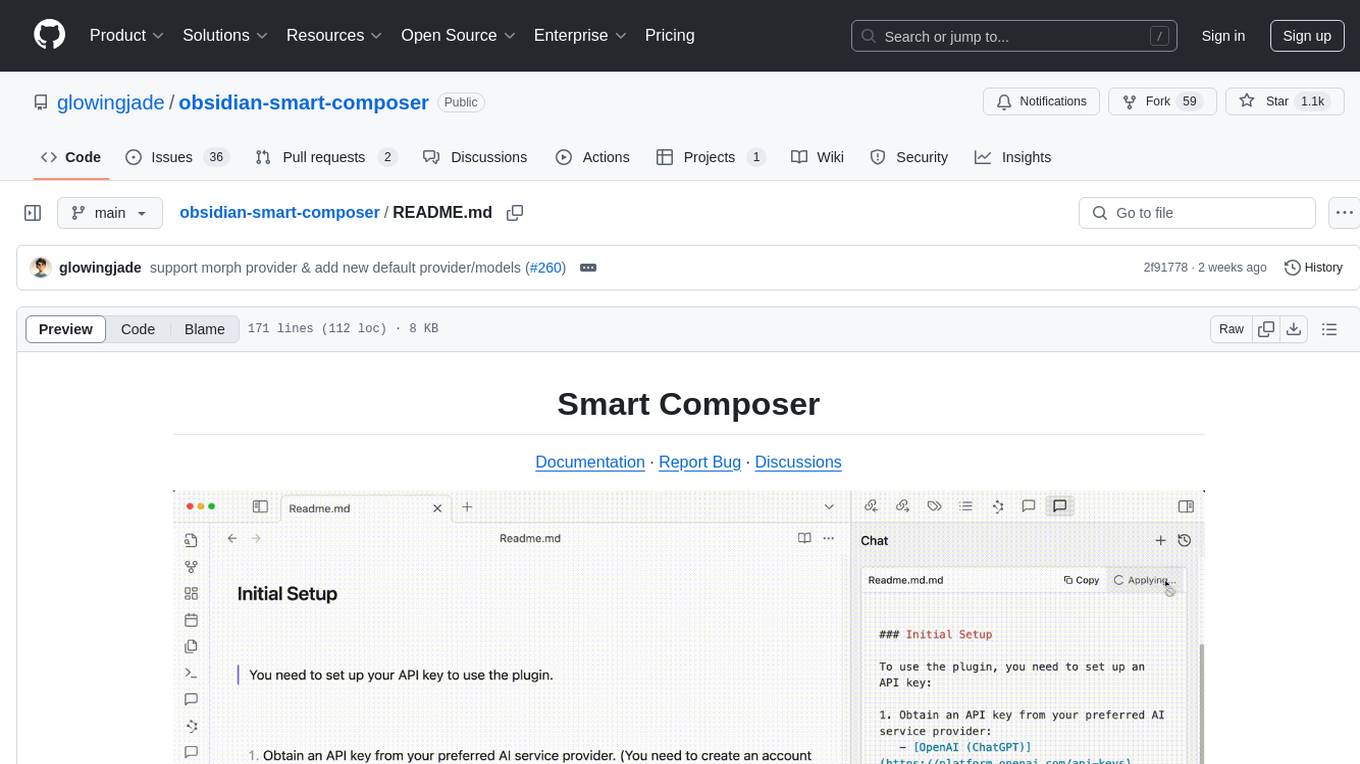
obsidian-smart-composer
Smart Composer is an Obsidian plugin that enhances note-taking and content creation by integrating AI capabilities. It allows users to efficiently write by referencing their vault content, providing contextual chat with precise context selection, multimedia context support for website links and images, document edit suggestions, and vault search for relevant notes. The plugin also offers features like custom model selection, local model support, custom system prompts, and prompt templates. Users can set up the plugin by installing it through the Obsidian community plugins, enabling it, and configuring API keys for supported providers like OpenAI, Anthropic, and Gemini. Smart Composer aims to streamline the writing process by leveraging AI technology within the Obsidian platform.
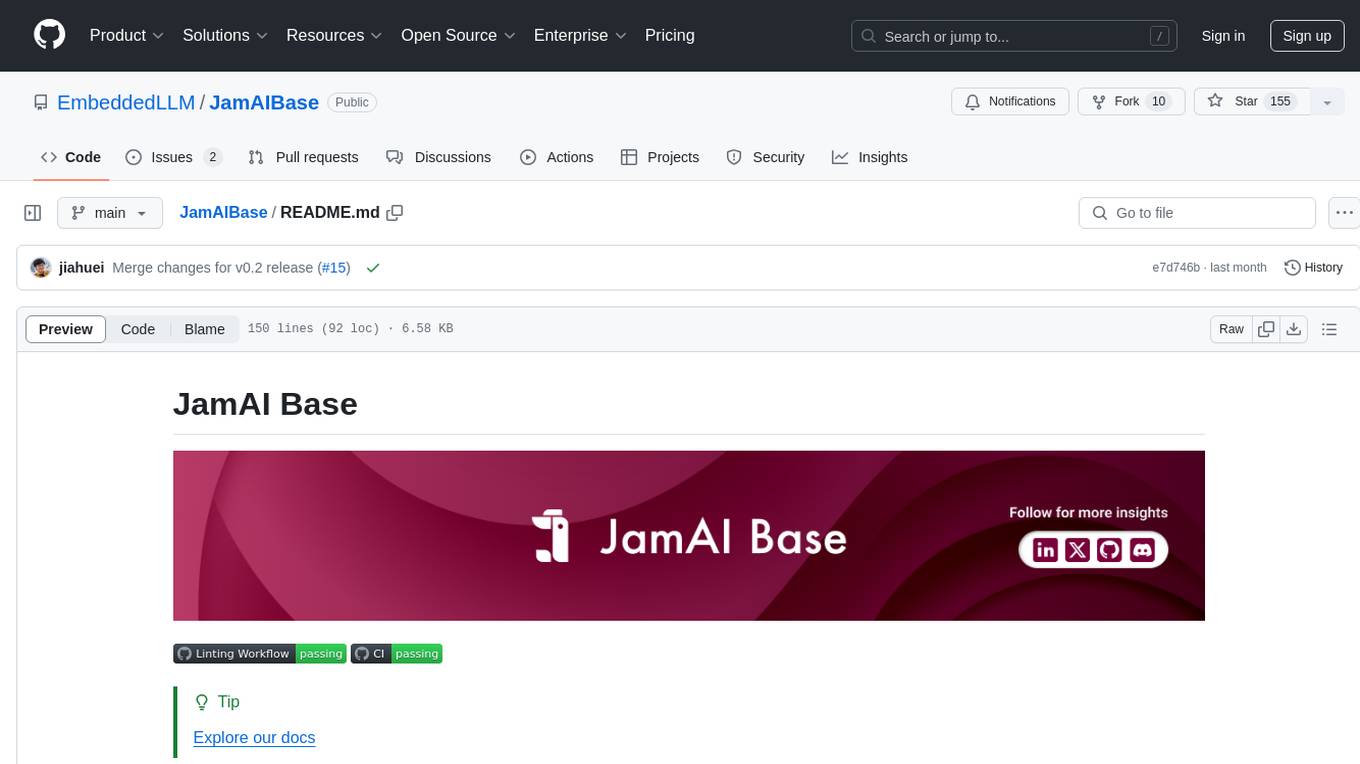
JamAIBase
JamAI Base is an open-source platform integrating SQLite and LanceDB databases with managed memory and RAG capabilities. It offers built-in LLM, vector embeddings, and reranker orchestration accessible through a spreadsheet-like UI and REST API. Users can transform static tables into dynamic entities, facilitate real-time interactions, manage structured data, and simplify chatbot development. The tool focuses on ease of use, scalability, flexibility, declarative paradigm, and innovative RAG techniques, making complex data operations accessible to users with varying technical expertise.

mattermost-plugin-agents
The Mattermost Agents Plugin integrates AI capabilities directly into your Mattermost workspace, allowing users to run local LLMs on their infrastructure or connect to cloud providers. It offers multiple AI assistants with specialized personalities, thread and channel summarization, action item extraction, meeting transcription, semantic search, smart reactions, direct conversations with AI assistants, and flexible LLM support. The plugin comes with comprehensive documentation, installation instructions, system requirements, and development guidelines for users to interact with AI features and configure LLM providers.
For similar tasks

LiteRT
LiteRT is Google's open-source high-performance runtime for on-device AI, previously known as TensorFlow Lite. The repository is currently not intended for open-source development, but aims to evolve to allow direct building and contributions. LiteRT supports Python versions 3.9, 3.10, 3.11 on Linux and MacOS. It ensures compatibility with existing .tflite file extension and format, offering conversion tools and continued active development under the name LiteRT.
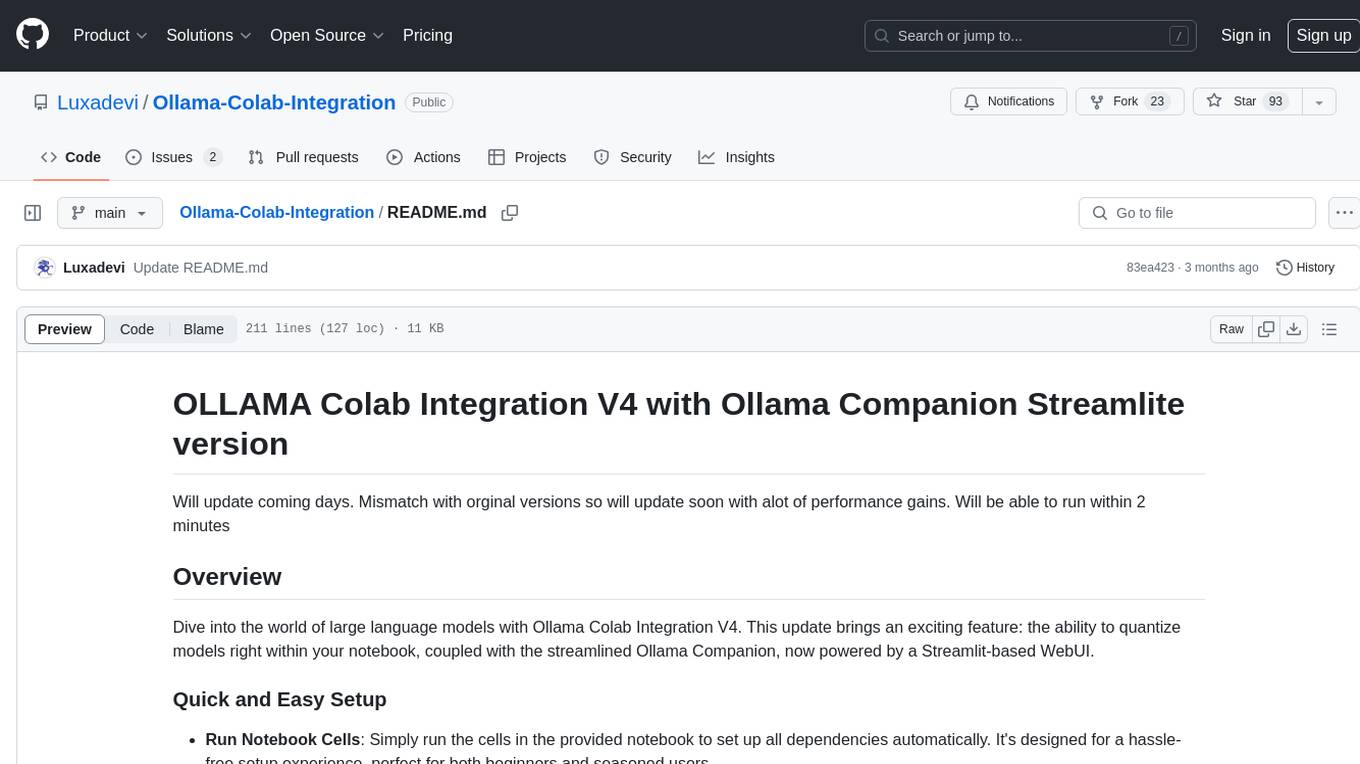
Ollama-Colab-Integration
Ollama Colab Integration V4 is a tool designed to enhance the interaction and management of large language models. It allows users to quantize models within their notebook environment, access a variety of models through a user-friendly interface, and manage public endpoints efficiently. The tool also provides features like LiteLLM proxy control, model insights, and customizable model file templating. Users can troubleshoot model loading issues, CPU fallback strategies, and manage VRAM and RAM effectively. Additionally, the tool offers functionalities for downloading model files from Hugging Face, model conversion with high precision, model quantization using Q and Kquants, and securely uploading converted models to Hugging Face.
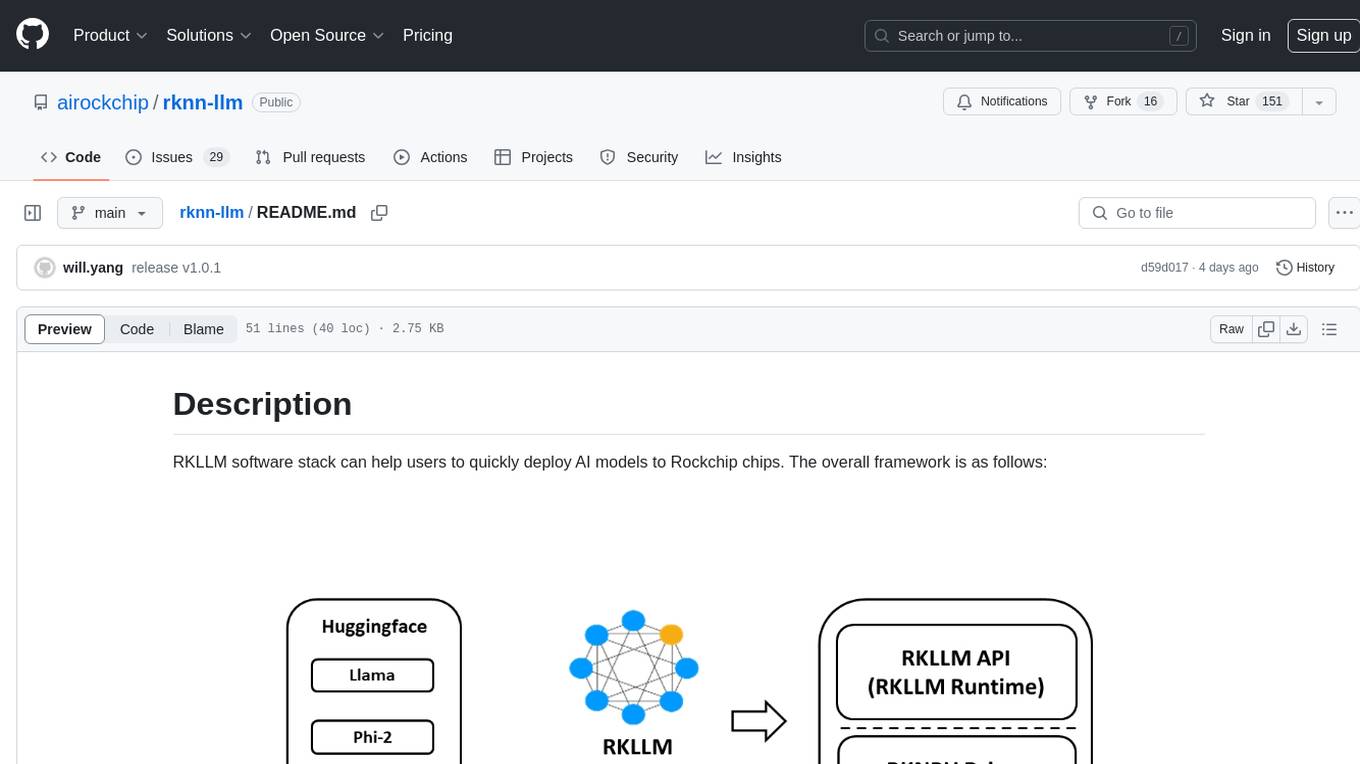
rknn-llm
RKLLM software stack is a toolkit designed to help users quickly deploy AI models to Rockchip chips. It consists of RKLLM-Toolkit for model conversion and quantization, RKLLM Runtime for deploying models on Rockchip NPU platform, and RKNPU kernel driver for hardware interaction. The toolkit supports RK3588 and RK3576 series chips and various models like TinyLLAMA, Qwen, Phi, ChatGLM3, Gemma, InternLM2, and MiniCPM. Users can download packages, docker images, examples, and docs from RKLLM_SDK. Additionally, RKNN-Toolkit2 SDK is available for deploying additional AI models.
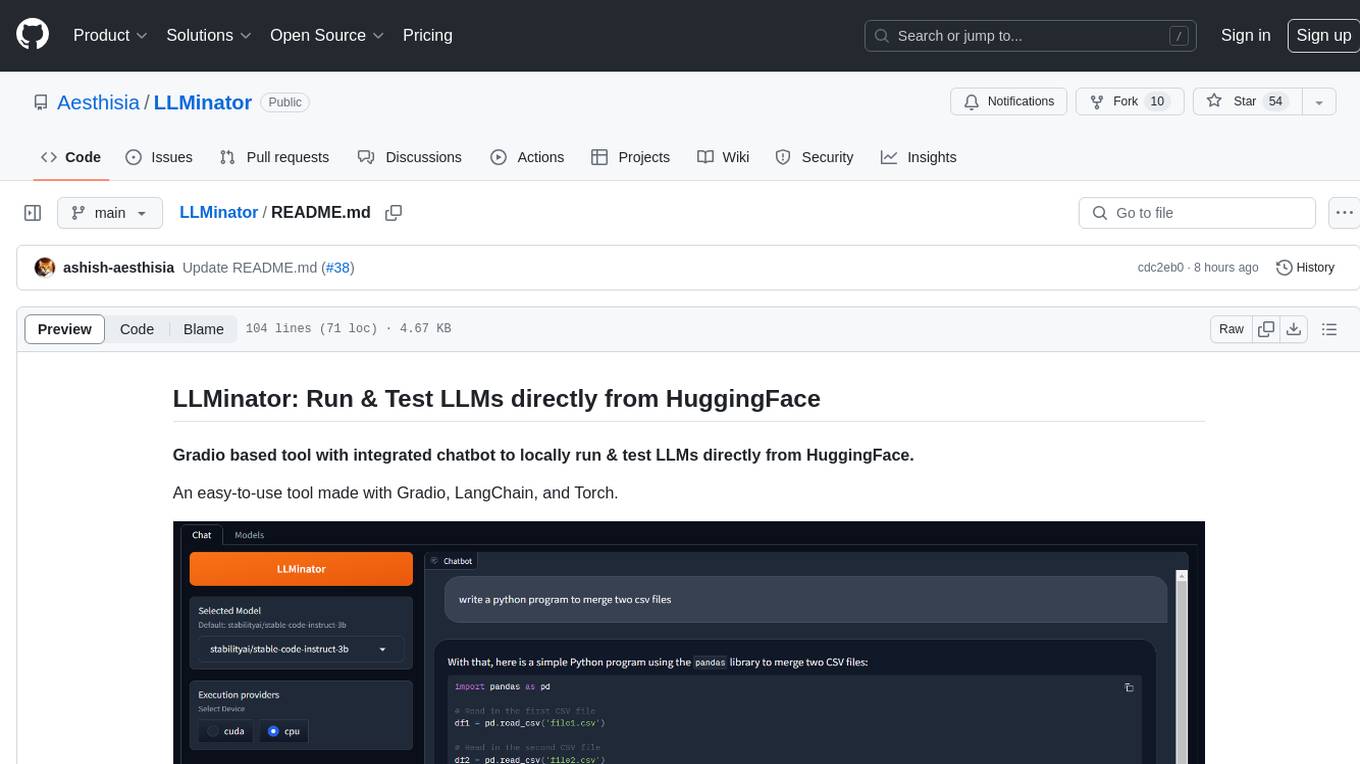
LLMinator
LLMinator is a Gradio-based tool with an integrated chatbot designed to locally run and test Language Model Models (LLMs) directly from HuggingFace. It provides an easy-to-use interface made with Gradio, LangChain, and Torch, offering features such as context-aware streaming chatbot, inbuilt code syntax highlighting, loading any LLM repo from HuggingFace, support for both CPU and CUDA modes, enabling LLM inference with llama.cpp, and model conversion capabilities.
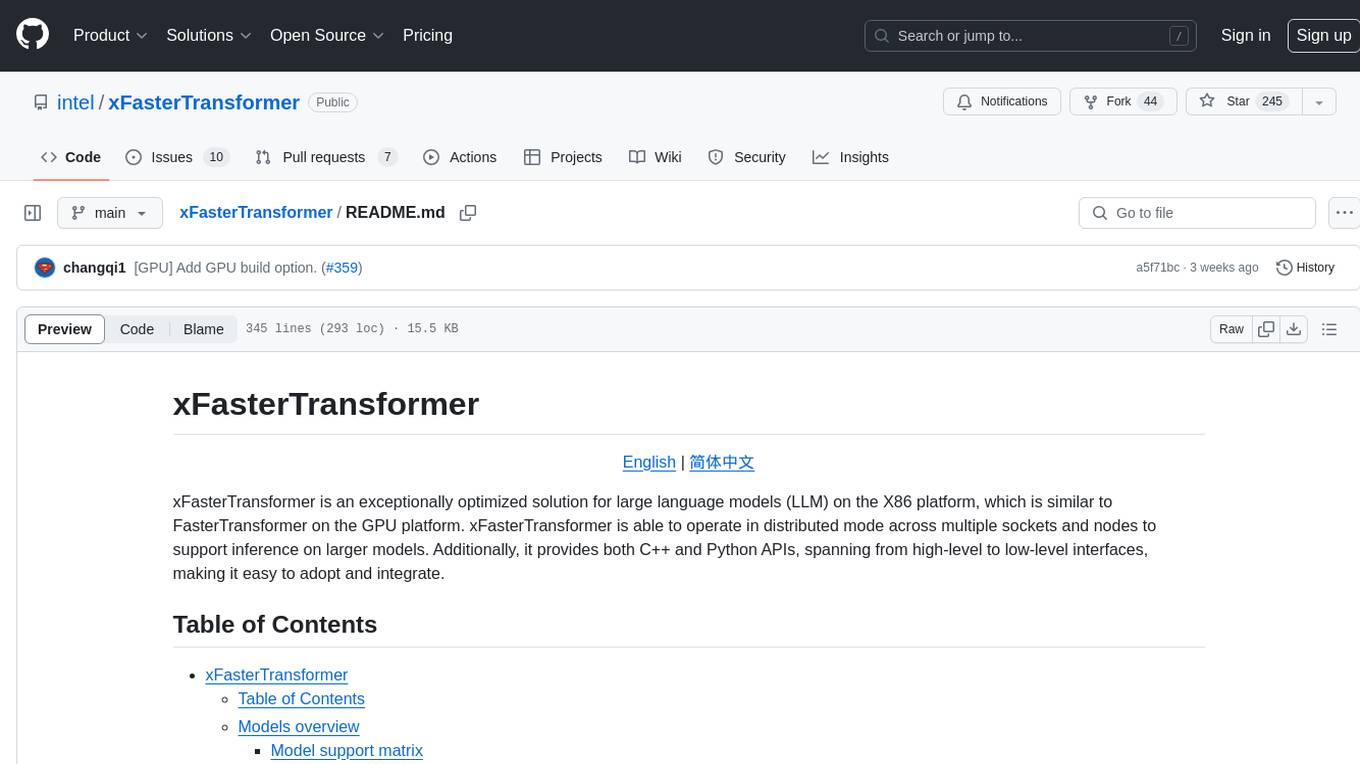
xFasterTransformer
xFasterTransformer is an optimized solution for Large Language Models (LLMs) on the X86 platform, providing high performance and scalability for inference on mainstream LLM models. It offers C++ and Python APIs for easy integration, along with example codes and benchmark scripts. Users can prepare models in a different format, convert them, and use the APIs for tasks like encoding input prompts, generating token ids, and serving inference requests. The tool supports various data types and models, and can run in single or multi-rank modes using MPI. A web demo based on Gradio is available for popular LLM models like ChatGLM and Llama2. Benchmark scripts help evaluate model inference performance quickly, and MLServer enables serving with REST and gRPC interfaces.
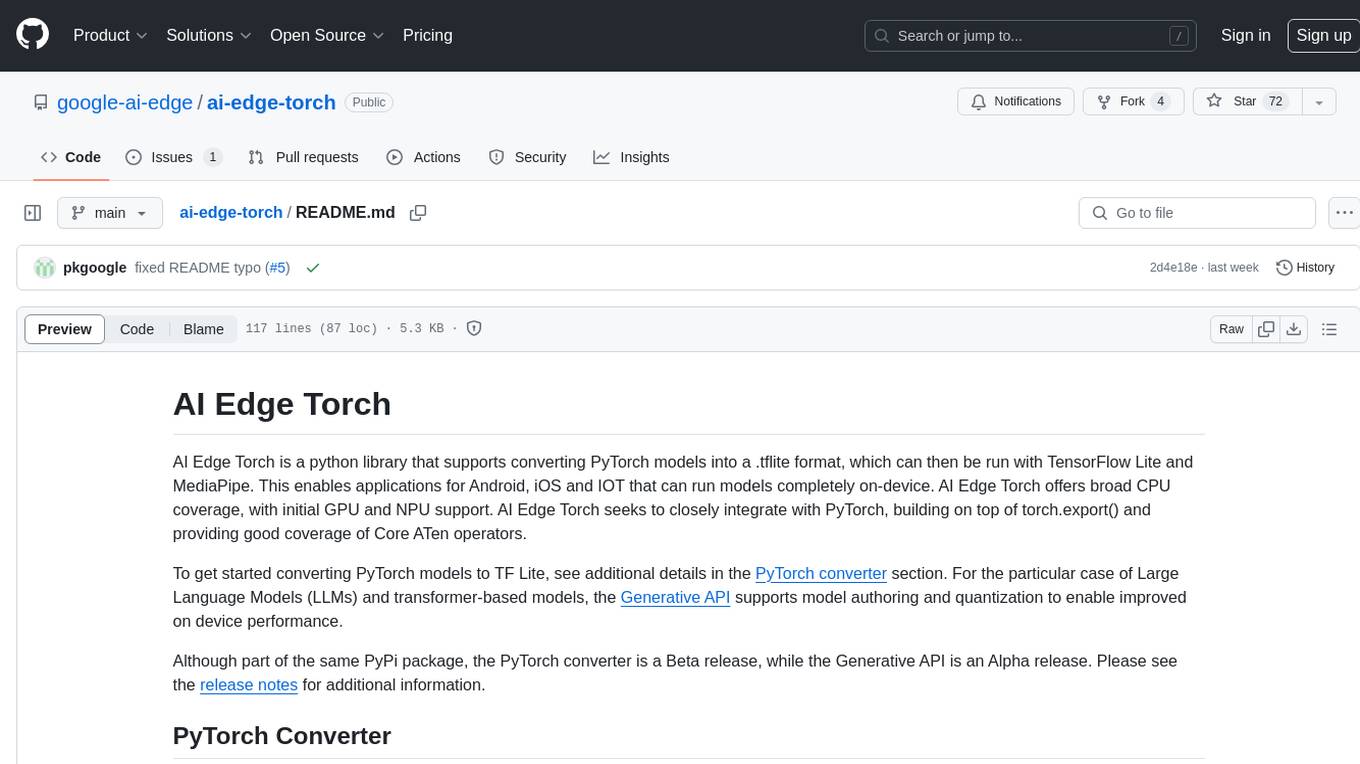
ai-edge-torch
AI Edge Torch is a Python library that supports converting PyTorch models into a .tflite format for on-device applications on Android, iOS, and IoT devices. It offers broad CPU coverage with initial GPU and NPU support, closely integrating with PyTorch and providing good coverage of Core ATen operators. The library includes a PyTorch converter for model conversion and a Generative API for authoring mobile-optimized PyTorch Transformer models, enabling easy deployment of Large Language Models (LLMs) on mobile devices.
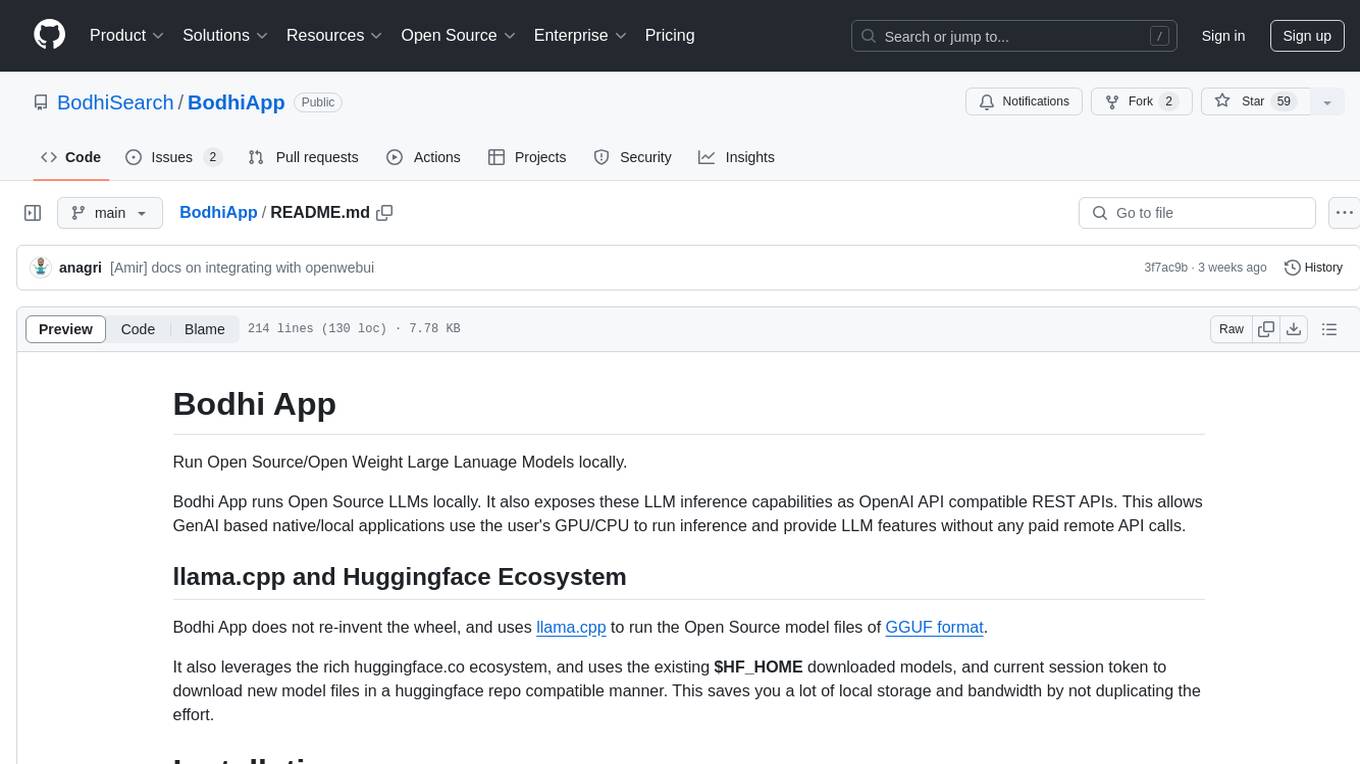
BodhiApp
Bodhi App runs Open Source Large Language Models locally, exposing LLM inference capabilities as OpenAI API compatible REST APIs. It leverages llama.cpp for GGUF format models and huggingface.co ecosystem for model downloads. Users can run fine-tuned models for chat completions, create custom aliases, and convert Huggingface models to GGUF format. The CLI offers commands for environment configuration, model management, pulling files, serving API, and more.
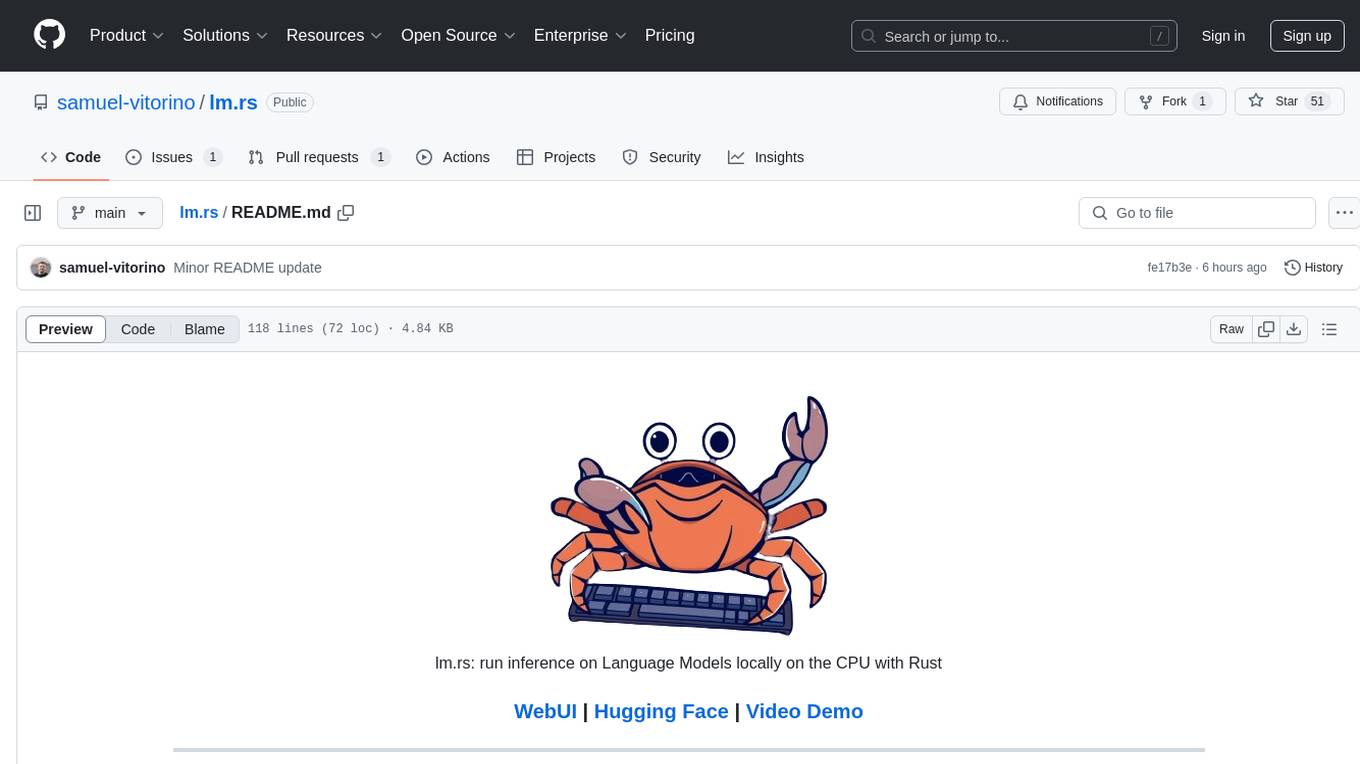
lm.rs
lm.rs is a tool that allows users to run inference on Language Models locally on the CPU using Rust. It supports LLama3.2 1B and 3B models, with a WebUI also available. The tool provides benchmarks and download links for models and tokenizers, with recommendations for quantization options. Users can convert models from Google/Meta on huggingface using provided scripts. The tool can be compiled with cargo and run with various arguments for model weights, tokenizer, temperature, and more. Additionally, a backend for the WebUI can be compiled and run to connect via the web interface.
For similar jobs

sweep
Sweep is an AI junior developer that turns bugs and feature requests into code changes. It automatically handles developer experience improvements like adding type hints and improving test coverage.

teams-ai
The Teams AI Library is a software development kit (SDK) that helps developers create bots that can interact with Teams and Microsoft 365 applications. It is built on top of the Bot Framework SDK and simplifies the process of developing bots that interact with Teams' artificial intelligence capabilities. The SDK is available for JavaScript/TypeScript, .NET, and Python.

ai-guide
This guide is dedicated to Large Language Models (LLMs) that you can run on your home computer. It assumes your PC is a lower-end, non-gaming setup.

classifai
Supercharge WordPress Content Workflows and Engagement with Artificial Intelligence. Tap into leading cloud-based services like OpenAI, Microsoft Azure AI, Google Gemini and IBM Watson to augment your WordPress-powered websites. Publish content faster while improving SEO performance and increasing audience engagement. ClassifAI integrates Artificial Intelligence and Machine Learning technologies to lighten your workload and eliminate tedious tasks, giving you more time to create original content that matters.

chatbot-ui
Chatbot UI is an open-source AI chat app that allows users to create and deploy their own AI chatbots. It is easy to use and can be customized to fit any need. Chatbot UI is perfect for businesses, developers, and anyone who wants to create a chatbot.

BricksLLM
BricksLLM is a cloud native AI gateway written in Go. Currently, it provides native support for OpenAI, Anthropic, Azure OpenAI and vLLM. BricksLLM aims to provide enterprise level infrastructure that can power any LLM production use cases. Here are some use cases for BricksLLM: * Set LLM usage limits for users on different pricing tiers * Track LLM usage on a per user and per organization basis * Block or redact requests containing PIIs * Improve LLM reliability with failovers, retries and caching * Distribute API keys with rate limits and cost limits for internal development/production use cases * Distribute API keys with rate limits and cost limits for students

uAgents
uAgents is a Python library developed by Fetch.ai that allows for the creation of autonomous AI agents. These agents can perform various tasks on a schedule or take action on various events. uAgents are easy to create and manage, and they are connected to a fast-growing network of other uAgents. They are also secure, with cryptographically secured messages and wallets.

griptape
Griptape is a modular Python framework for building AI-powered applications that securely connect to your enterprise data and APIs. It offers developers the ability to maintain control and flexibility at every step. Griptape's core components include Structures (Agents, Pipelines, and Workflows), Tasks, Tools, Memory (Conversation Memory, Task Memory, and Meta Memory), Drivers (Prompt and Embedding Drivers, Vector Store Drivers, Image Generation Drivers, Image Query Drivers, SQL Drivers, Web Scraper Drivers, and Conversation Memory Drivers), Engines (Query Engines, Extraction Engines, Summary Engines, Image Generation Engines, and Image Query Engines), and additional components (Rulesets, Loaders, Artifacts, Chunkers, and Tokenizers). Griptape enables developers to create AI-powered applications with ease and efficiency.
